货币金融学第六章
- 格式:ppt
- 大小:1.58 MB
- 文档页数:40
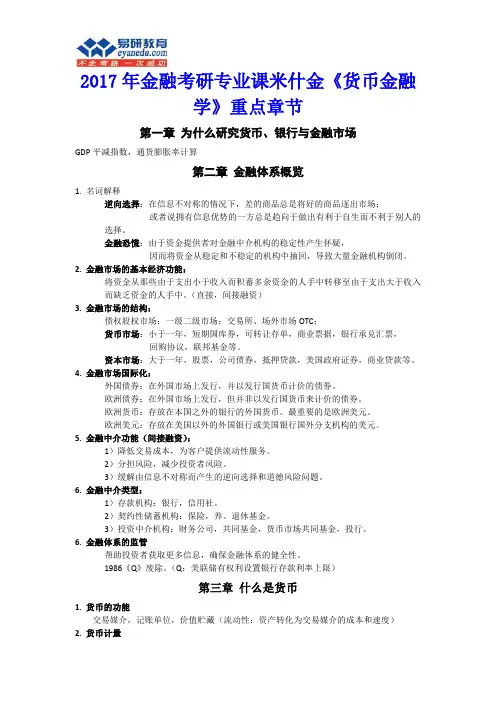
2017年金融考研专业课米什金《货币金融学》重点章节第一章为什么研究货币、银行与金融市场GDP平减指数,通货膨胀率计算第二章金融体系概览1.名词解释逆向选择:在信息不对称的情况下,差的商品总是将好的商品逐出市场;或者说拥有信息优势的一方总是趋向于做出有利于自生而不利于别人的选择。
金融恐慌:由于资金提供者对金融中介机构的稳定性产生怀疑,因而将资金从稳定和不稳定的机构中抽回,导致大量金融机构倒闭。
2.金融市场的基本经济功能:将资金从那些由于支出小于收入而积蓄多余资金的人手中转移至由于支出大于收入而缺乏资金的人手中。
(直接,间接融资)3.金融市场的结构:债权股权市场;一级二级市场;交易所、场外市场OTC;货币市场:小于一年,短期国库券,可转让存单,商业票据,银行承兑汇票,回购协议,联邦基金等。
资本市场:大于一年,股票,公司债券,抵押贷款,美国政府证券,商业贷款等。
4.金融市场国际化:外国债券:在外国市场上发行,并以发行国货币计价的债券。
欧洲债券:在外国市场上发行,但并非以发行国货币来计价的债券。
欧洲货币:存放在本国之外的银行的外国货币。
最重要的是欧洲美元。
欧洲美元:存放在美国以外的外国银行或美国银行国外分支机构的美元。
5.金融中介功能(间接融资):1)降低交易成本,为客户提供流动性服务。
2)分担风险,减少投资者风险。
3)缓解由信息不对称而产生的逆向选择和道德风险问题。
6.金融中介类型:1)存款机构:银行,信用社。
2)契约性储蓄机构:保险,养、退休基金。
3)投资中介机构:财务公司,共同基金,货币市场共同基金,投行。
6.金融体系的监管帮助投资者获取更多信息,确保金融体系的健全性。
1986《Q》废除。
(Q:美联储有权利设置银行存款利率上限)第三章什么是货币1.货币的功能交易媒介,记账单位,价值贮藏(流动性:资产转化为交易媒介的成本和速度)2.货币计量M1=通货+旅行者支票+活期存款+其他支票存款M2=M1+小额定期存款+储蓄存款与货币市场存款账户+货币市场共同基金份额第四章理解利率1.四种信用市场工具1)普通贷款:到期支付本金与利息,如商业贷款。

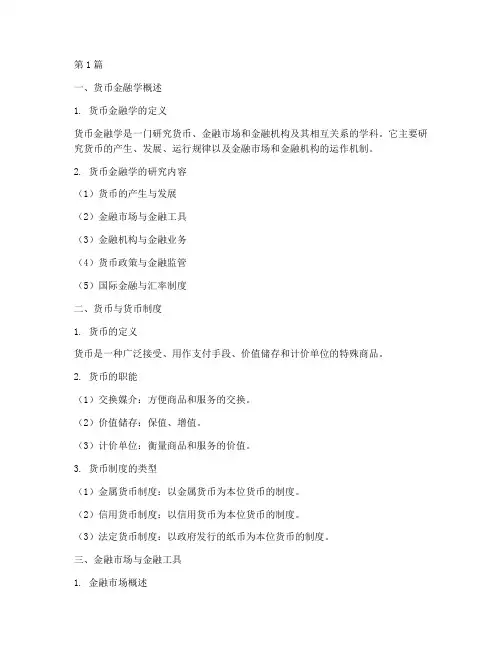
第1篇一、货币金融学概述1. 货币金融学的定义货币金融学是一门研究货币、金融市场和金融机构及其相互关系的学科。
它主要研究货币的产生、发展、运行规律以及金融市场和金融机构的运作机制。
2. 货币金融学的研究内容(1)货币的产生与发展(2)金融市场与金融工具(3)金融机构与金融业务(4)货币政策与金融监管(5)国际金融与汇率制度二、货币与货币制度1. 货币的定义货币是一种广泛接受、用作支付手段、价值储存和计价单位的特殊商品。
2. 货币的职能(1)交换媒介:方便商品和服务的交换。
(2)价值储存:保值、增值。
(3)计价单位:衡量商品和服务的价值。
3. 货币制度的类型(1)金属货币制度:以金属货币为本位货币的制度。
(2)信用货币制度:以信用货币为本位货币的制度。
(3)法定货币制度:以政府发行的纸币为本位货币的制度。
三、金融市场与金融工具1. 金融市场概述金融市场是指资金供应者与资金需求者之间进行资金交易的市场。
金融市场分为货币市场、资本市场、外汇市场、衍生品市场等。
2. 金融工具概述金融工具是金融市场上的交易对象,包括货币、债券、股票、衍生品等。
(1)货币市场工具:如银行承兑汇票、商业票据、回购协议等。
(2)资本市场工具:如债券、股票等。
(3)外汇市场工具:如外汇期货、外汇期权等。
(4)衍生品市场工具:如远期合约、掉期合约、期权等。
四、金融机构与金融业务1. 金融机构概述金融机构是指从事金融业务的特殊企业,包括银行、保险公司、证券公司、基金公司等。
2. 金融机构的类型(1)存款性金融机构:如商业银行、储蓄银行等。
(2)非存款性金融机构:如保险公司、证券公司、基金公司等。
3. 金融机构的业务(1)存款业务:吸收公众存款,为公众提供支付结算服务。
(2)贷款业务:向企业、个人提供贷款。
(3)投资业务:投资股票、债券、基金等。
(4)结算业务:为客户提供资金清算、支付结算服务。
五、货币政策与金融监管1. 货币政策概述货币政策是指中央银行运用货币政策工具,调节货币供应量、利率和汇率,以实现宏观经济目标的政策。
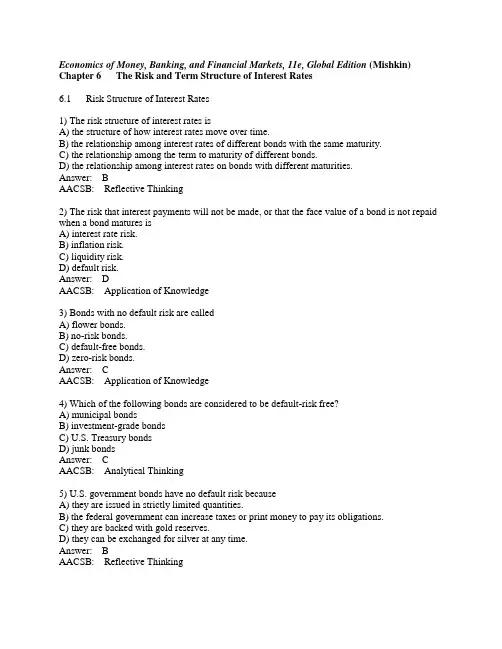
Economics of Money, Banking, and Financial Markets, 11e, Global Edition (Mishkin) Chapter 6 The Risk and Term Structure of Interest Rates6.1 Risk Structure of Interest Rates1) The risk structure of interest rates isA) the structure of how interest rates move over time.B) the relationship among interest rates of different bonds with the same maturity.C) the relationship among the term to maturity of different bonds.D) the relationship among interest rates on bonds with different maturities.Answer: BAACSB: Reflective Thinking2) The risk that interest payments will not be made, or that the face value of a bond is not repaid when a bond matures isA) interest rate risk.B) inflation risk.C) liquidity risk.D) default risk.Answer: DAACSB: Application of Knowledge3) Bonds with no default risk are calledA) flower bonds.B) no-risk bonds.C) default-free bonds.D) zero-risk bonds.Answer: CAACSB: Application of Knowledge4) Which of the following bonds are considered to be default-risk free?A) municipal bondsB) investment-grade bondsC) U.S. Treasury bondsD) junk bondsAnswer: CAACSB: Analytical Thinking5) U.S. government bonds have no default risk becauseA) they are issued in strictly limited quantities.B) the federal government can increase taxes or print money to pay its obligations.C) they are backed with gold reserves.D) they can be exchanged for silver at any time.Answer: BAACSB: Reflective Thinking6) The spread between the interest rates on bonds with default risk and default-free bonds is called theA) risk premium.B) junk margin.C) bond margin.D) default premium.Answer: AAACSB: Application of Knowledge7) If the probability of a bond default increases because corporations begin to suffer large losses, then the default risk on corporate bonds will ________ and the expected return on these bonds will ________, everything else held constant.A) decrease; increaseB) decrease; decreaseC) increase; increaseD) increase; decreaseAnswer: DAACSB: Reflective Thinking8) A bond with default risk will always have a ________ risk premium and an increase in its default risk will ________ the risk premium.A) positive; raiseB) positive; lowerC) negative; raiseD) negative; lowerAnswer: AAACSB: Reflective Thinking9) If a corporation begins to suffer large losses, then the default risk on the corporate bond willA) increase and the bond's return will become more uncertain, meaning the expected return on the corporate bond will fall.B) increase and the bond's return will become less uncertain, meaning the expected return on the corporate bond will fall.C) decrease and the bond's return will become less uncertain, meaning the expected return on the corporate bond will fall.D) decrease and the bond's return will become less uncertain, meaning the expected return on the corporate bond will rise.Answer: AAACSB: Reflective Thinking10) If the possibility of a default increases because corporations begin to suffer losses, then the default risk on corporate bonds will ________, and the bonds' returns will become ________ uncertain, meaning that the expected return on these bonds will decrease, everything else held constant.A) increase; lessB) increase; moreC) decrease; lessD) decrease; moreAnswer: BAACSB: Reflective Thinking11) Other things being equal, an increase in the default risk of corporate bonds shifts the demand curve for corporate bonds to the ________ and the demand curve for Treasury bonds to the________.A) right; rightB) right; leftC) left; rightD) left; leftAnswer: CAACSB: Reflective Thinking12) Other things being equal, a decrease in the default risk of corporate bonds shifts the demand curve for corporate bonds to the ________ and the demand curve for Treasury bonds to the________.A) right; rightB) right; leftC) left; rightD) left; leftAnswer: BAACSB: Reflective Thinking13) A(n) ________ in the riskiness of corporate bonds will ________ the price of corporate bonds and ________ the yield on corporate bonds, all else equal.A) increase; increase; increaseB) increase; decrease; increaseC) decrease; increase; increaseD) decrease; decrease;decreaseAnswer: BAACSB: Reflective Thinking14) An increase in the riskiness of corporate bonds will ________ the price of corporate bonds and ________ the price of Treasury bonds, everything else held constant.A) increase; increaseB) reduce; reduceC) reduce; increaseD) increase; reduceAnswer: CAACSB: Reflective Thinking15) A decrease in the riskiness of corporate bonds will ________ the price of corporate bonds and ________ the price of Treasury bonds, everything else held constant.A) increase; increaseB) reduce; reduceC) reduce; increaseD) increase; reduceAnswer: DAACSB: Reflective Thinking16) An increase in the riskiness of corporate bonds will ________ the yield on corporate bonds and ________ the yield on Treasury securities, everything else held constant.A) increase; increaseB) reduce; reduceC) increase; reduceD) reduce; increaseAnswer: CAACSB: Reflective Thinking17) A decrease in the riskiness of corporate bonds will ________ the yield on corporate bonds and ________ the yield on Treasury securities, everything else held constant.A) increase; increaseB) decrease; decreaseC) increase; decreaseD) decrease; increaseAnswer: DAACSB: Reflective Thinking18) An increase in default risk on corporate bonds ________ the demand for these bonds, but ________ the demand for default-free bonds, everything else held constant.A) increases; lowersB) lowers; increasesC) does not change; greatly increasesD) moderately lowers; does not changeAnswer: BAACSB: Reflective Thinking19) A decrease in default risk on corporate bonds ________ the demand for these bonds, and________ the demand for default-free bonds, everything else held constant.A) increases; lowersB) lowers; increasesC) does not change; greatly increasesD) moderately lowers; does not changeAnswer: AAACSB: Reflective Thinking20) As default risk increases, the expected return on corporate bonds ________, and the return becomes ________ uncertain, everything else held constant.A) increases; lessB) increases; moreC) decreases; lessD) decreases; moreAnswer: DAACSB: Reflective Thinking21) As default risk decreases, the expected return on corporate bonds ________, and the return becomes ________ uncertain, everything else held constant.A) increases; lessB) increases; moreC) decreases; lessD) decreases; moreAnswer: AAACSB: Reflective Thinking22) As their relative riskiness ________, the expected return on corporate bonds ________ relative to the expected return on default-free bonds, everything else held constant.A) increases; increasesB) increases; decreasesC) decreases; decreasesD) decreases; does not changeAnswer: BAACSB: Reflective Thinking23) Which of the following statements are TRUE?A) A decrease in default risk on corporate bonds lowers the demand for these bonds, but increases the demand for default-free bonds.B) The expected return on corporate bonds decreases as default risk increases.C) A corporate bond's return becomes less uncertain as default risk increases.D) As their relative riskiness increases, the expected return on corporate bonds increases relative to the expected return on default-free bonds.Answer: BAACSB: Reflective Thinking24) Everything else held constant, if the federal government were to guarantee today that it will pay creditors if a corporation goes bankrupt in the future, the interest rate on corporate bonds will ________ and the interest rate on Treasury securities will ________.A) increase; increaseB) increase; decreaseC) decrease; increaseD) decrease; decreaseAnswer: CAACSB: Reflective Thinking25) Bonds with relatively high risk of default are calledA) Brady bonds.B) junk bonds.C) zero coupon bonds.D) investment grade bonds.Answer: BAACSB: Analytical Thinking26) Junk bonds, bonds with a low bond rating, are also known asA) high-yield bonds.B) investment grade bonds.C) high quality bonds.D) zero-coupon bonds.Answer: AAACSB: Application of Knowledge27) Bonds with relatively low risk of default are called ________ securities and have a rating of Baa (or BBB) and above; bonds with ratings below Baa (or BBB) have a higher default risk and are called ________.A) investment grade; lower gradeB) investment grade; junk bondsC) high quality; lower gradeD) high quality; junk bondsAnswer: BAACSB: Analytical Thinking28) Which of the following bonds would have the highest default risk?A) municipal bondsB) investment-grade bondsC) U.S. Treasury bondsD) junk bondsAnswer: DAACSB: Reflective Thinking29) Which of the following long-term bonds has the highest interest rate?A) corporate Baa bondsB) U.S. Treasury bondsC) corporate Aaa bondsD) municipal bondsAnswer: AAACSB: Reflective Thinking30) Which of the following securities has the lowest interest rate?A) junk bondsB) U.S. Treasury bondsC) investment-grade bondsD) corporate Baa bondsAnswer: BAACSB: Reflective Thinking31) The spread between interest rates on low quality corporate bonds and U.S. government bondsA) widened significantly during the Great Depression.B) narrowed significantly during the Great Depression.C) narrowed moderately during the Great Depression.D) did not change during the Great Depression.Answer: AAACSB: Reflective Thinking32) During the Great Depression years 1930-1933 there was a very high rate of business failures and defaults, we would expect the risk premium for ________ bonds to be very high.A) U.S. TreasuryB) corporate AaaC) municipalD) corporate BaaAnswer: DAACSB: Reflective Thinking33) Risk premiums on corporate bonds tend to ________ during business cycle expansions and ________ during recessions, everything else held constant.A) increase; increaseB) increase; decreaseC) decrease; increaseD) decrease; decreaseAnswer: CAACSB: Reflective Thinking34) The collapse of the subprime mortgage marketA) did not affect the corporate bond market.B) increased the perceived riskiness of Treasury securities.C) reduced the Baa-Aaa spread.D) increased the Baa-Aaa spread.Answer: DAACSB: Reflective Thinking35) The collapse of the subprime mortgage market increased the spread between Baa and default-free U.S. Treasury bonds. This is due toA) a reduction in risk.B) a reduction in maturity.C) a flight to quality.D) a flight to liquidity.Answer: CAACSB: Analytical Thinking36) During a "flight to quality"A) the spread between Treasury bonds and Baa bonds increases.B) the spread between Treasury bonds and Baa bonds decreases.C) the spread between Treasury bonds and Baa bonds is not affected.D) the change in the spread between Treasury bonds and Baa bonds cannot be predicted. Answer: AAACSB: Reflective Thinking37) If you have a very low tolerance for risk, which of the following bonds would you be least likely to hold in your portfolio?A) a U.S. Treasury bondB) a municipal bondC) a corporate bond with a rating of AaaD) a corporate bond with a rating of BaaAnswer: DAACSB: Reflective Thinking38) Which of the following statements is TRUE?A) A liquid asset is one that can be quickly and cheaply converted into cash.B) The demand for a bond declines when it becomes less liquid, decreasing the interest rate spread between it and relatively more liquid bonds.C) The differences in bond interest rates reflect differences in default risk only.D) The corporate bond market is the most liquid bond market.Answer: AAACSB: Reflective Thinking39) Corporate bonds are not as liquid as government bonds becauseA) fewer corporate bonds for any one corporation are traded, making them more costly to sell.B) the corporate bond rating must be calculated each time they are traded.C) corporate bonds are not callable.D) corporate bonds cannot be resold.Answer: AAACSB: Reflective Thinking40) When the Treasury bond market becomes more liquid, other things equal, the demand curve for corporate bonds shifts to the ________ and the demand curve for Treasury bonds shifts to the ________.A) right; rightB) right; leftC) left; rightD) left; leftAnswer: CAACSB: Reflective Thinking41) When the Treasury bond market becomes less liquid, other things equal, the demand curve for corporate bonds shifts to the ________ and the demand curve for Treasury bonds shifts to the ________.A) right; rightB) right; leftC) left; rightD) left; leftAnswer: BAACSB: Reflective Thinking42) A decrease in the liquidity of corporate bonds, other things being equal, shifts the demand curve for corporate bonds to the ________ and the demand curve for Treasury bonds shifts to the ________.A) right; rightB) right; leftC) left; leftD) left; rightAnswer: DAACSB: Reflective Thinking43) An increase in the liquidity of corporate bonds, other things being equal, shifts the demand curve for corporate bonds to the ________ and the demand curve for Treasury bonds shifts to the ________.A) right; rightB) right; leftC) left; leftD) left; rightAnswer: BAACSB: Reflective Thinking44) A(n) ________ in the liquidity of corporate bonds will ________ the price of corporate。
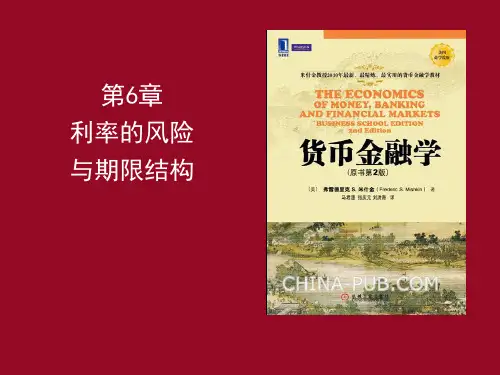
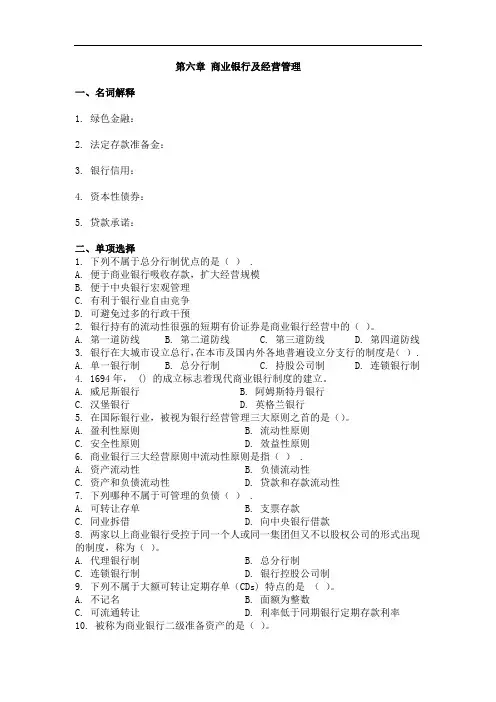
第六章商业银行及经营管理一、名词解释1. 绿色金融:2. 法定存款准备金:3. 银行信用:4. 资本性债券:5. 贷款承诺:二、单项选择1. 下列不属于总分行制优点的是() .A. 便于商业银行吸收存款,扩大经营规模B. 便于中央银行宏观管理C. 有利于银行业自由竞争D. 可避免过多的行政干预2. 银行持有的流动性很强的短期有价证券是商业银行经营中的()。
A. 第一道防线B. 第二道防线C. 第三道防线D. 第四道防线3. 银行在大城市设立总行,在本市及国内外各地普遍设立分支行的制度是() .A. 单一银行制B. 总分行制C. 持股公司制D. 连锁银行制4. 1694年, () 的成立标志着现代商业银行制度的建立。
A. 威尼斯银行B. 阿姆斯特丹银行C. 汉堡银行D. 英格兰银行5. 在国际银行业,被视为银行经营管理三大原则之首的是()。
A. 盈利性原则B. 流动性原则C. 安全性原则D. 效益性原则6. 商业银行三大经营原则中流动性原则是指() .A. 资产流动性B. 负债流动性C. 资产和负债流动性D. 贷款和存款流动性7. 下列哪种不属于可管理的负债() .A. 可转让存单B. 支票存款C. 同业拆借D. 向中央银行借款8. 两家以上商业银行受控于同一个人或同一集团但又不以股权公司的形式出现的制度,称为()。
A. 代理银行制B. 总分行制C. 连锁银行制D. 银行控股公司制9. 下列不属于大额可转让定期存单(CDs) 特点的是()。
A. 不记名B. 面额为整数C. 可流通转让D. 利率低于同期银行定期存款利率10. 被称为商业银行二级准备资产的是()。
A. 在央行存款B. 在同业存款C. 短期政府债券D. 库存现金11. 1897年在上海成立的()标志着中国现代银行的产生。
A. 交通银行B. 浙江兴业银行C. 中国通商银行D. 北洋银行12.下列银行资产中流动性最高的是()。
A. 结算过程中占用的现金B. 消费贷款C. 政府债券D. 准备金存款13. 一般地,当一家商业银行面临准备金不足时,它首先会() .A. 回收贷款B. 向央行借款C. 出售债券D. 向同业拆借14. 利率敏感性资产与利率敏感性负债的差额称为() .A. 持续期缺口B. 利率敏感性指数C. 利率风险指数D. 利率敏感性缺口15, 商业银行把资金从盈余者手中转移到短缺者手中,使闲置资金得到充分的运用,这种职能被称为商业银行的()职能。
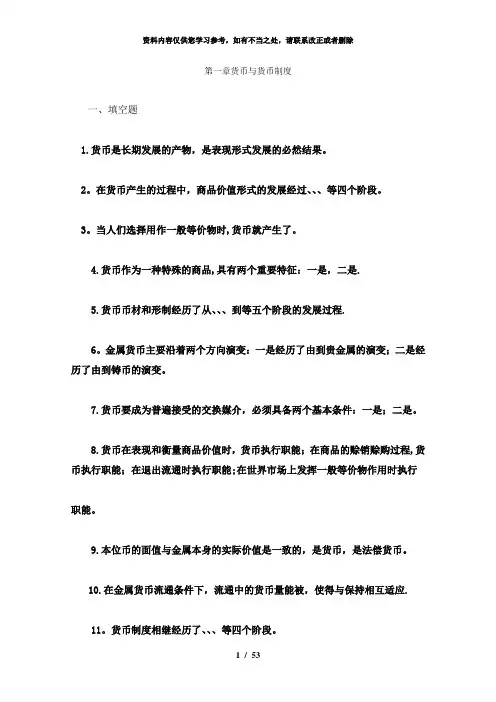
第一章货币与货币制度一、填空题1.货币是长期发展的产物,是表现形式发展的必然结果。
2。
在货币产生的过程中,商品价值形式的发展经过、、、等四个阶段。
3。
当人们选择用作一般等价物时,货币就产生了。
4.货币作为一种特殊的商品,具有两个重要特征:一是,二是.5.货币币材和形制经历了从、、、到等五个阶段的发展过程.6。
金属货币主要沿着两个方向演变:一是经历了由到贵金属的演变;二是经历了由到铸币的演变。
7.货币要成为普遍接受的交换媒介,必须具备两个基本条件:一是;二是。
8.货币在表现和衡量商品价值时,货币执行职能;在商品的赊销赊购过程,货币执行职能;在退出流通时执行职能;在世界市场上发挥一般等价物作用时执行职能。
9.本位币的面值与金属本身的实际价值是一致的,是货币,是法偿货币。
10.在金属货币流通条件下,流通中的货币量能被,使得与保持相互适应.11。
货币制度相继经历了、、、等四个阶段。
12。
银行券是银行发行的一种,即银行保证持有人可以随时向签发银行兑换相应的一种凭证,通常以作为发行准备。
13.铸币的发展有一个从足值到的过程。
14。
国家垄断辅币铸造,归国家所有,构成重要的财政收入来源。
15.在金本位制下,一国汇率围绕上下波动,汇率波动界限是。
16。
平行本位制下,金币和银币是按照比价流通,双本位制下,金币和银币则按照比价流通.17.在跛行本位制下,可以自由铸造而不能自由铸造。
18.在金汇兑本位制下,本币只能先兑换,再兑换。
19。
存储于银行电子计算机系统内可利用银行卡随时提取现金或支付的存款货币称为。
20.货币金本位制有、、等三种形式。
21.金币本位制的三大特征是指、、。
22.信用货币主要由现金和存款组成,其中现金是对公众的负债,存款则是对存款人的负债。
23。
人民币的发行权属于,是全国惟一的货币发行机关。
24。
信用货币的形式有、纸币和等形式。
25。
货币成为普遍接受的交换媒介须具备两个基本条件:一是,二是。
26。
规定货币单位包括规定和单位货币的价值两个方面.27.确定货币单位价值因货币制度不同而有差异:在金属货币流通时代,是确定单位货币所含的;在与黄金挂钩的不兑现货币流通时期,是确定本币单位的,或确定本国货币与的固定比价;黄金非货币化后,则是如何维持本币与的比价.28。
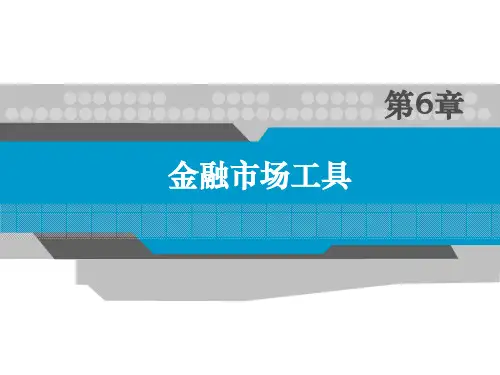
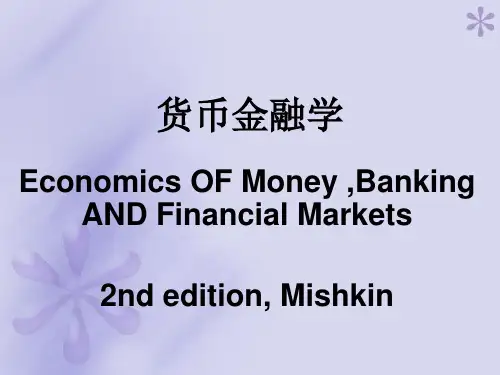
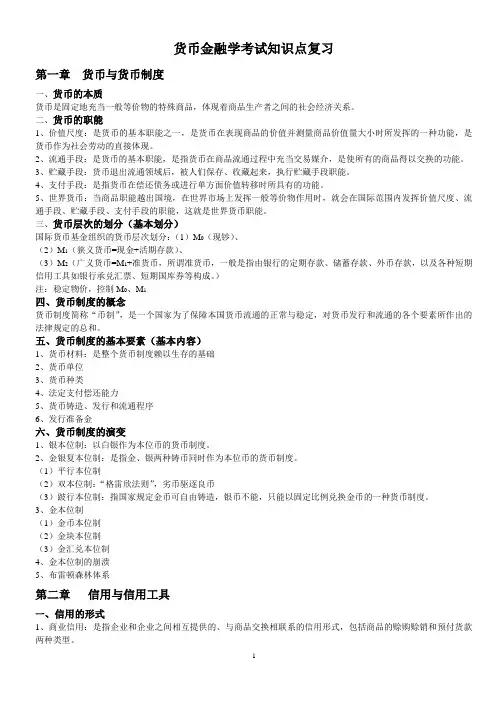
货币金融学考试知识点复习第一章货币与货币制度一、货币的本质货币是固定地充当一般等价物的特殊商品,体现着商品生产者之间的社会经济关系。
二、货币的职能1、价值尺度:是货币的基本职能之一,是货币在表现商品的价值并测量商品价值量大小时所发挥的一种功能,是货币作为社会劳动的直接体现。
2、流通手段:是货币的基本职能,是指货币在商品流通过程中充当交易媒介,是使所有的商品得以交换的功能。
3、贮藏手段:货币退出流通领域后,被人们保存、收藏起来,执行贮藏手段职能。
4、支付手段:是指货币在偿还债务或进行单方面价值转移时所具有的功能。
5、世界货币:当商品职能越出国境,在世界市场上发挥一般等价物作用时,就会在国际范围内发挥价值尺度、流通手段、贮藏手段、支付手段的职能,这就是世界货币职能。
三、货币层次的划分(基本划分)国际货币基金组织的货币层次划分:(1)M0(现钞)、(2)M1(狭义货币=现金+活期存款)、(3)M2(广义货币=M1+准货币,所谓准货币,一般是指由银行的定期存款、储蓄存款、外币存款,以及各种短期信用工具如银行承兑汇票、短期国库券等构成。
)注:稳定物价,控制M0、M1四、货币制度的概念货币制度简称“币制”,是一个国家为了保障本国货币流通的正常与稳定,对货币发行和流通的各个要素所作出的法律规定的总和。
五、货币制度的基本要素(基本内容)1、货币材料:是整个货币制度赖以生存的基础2、货币单位3、货币种类4、法定支付偿还能力5、货币铸造、发行和流通程序6、发行准备金六、货币制度的演变1、银本位制:以白银作为本位币的货币制度。
2、金银复本位制:是指金、银两种铸币同时作为本位币的货币制度。
(1)平行本位制(2)双本位制:“格雷欣法则”,劣币驱逐良币(3)跛行本位制:指国家规定金币可自由铸造,银币不能,只能以固定比例兑换金币的一种货币制度。
3、金本位制(1)金币本位制(2)金块本位制(3)金汇兑本位制4、金本位制的崩溃5、布雷顿森林体系第二章信用与信用工具一、信用的形式1、商业信用:是指企业和企业之间相互提供的、与商品交换相联系的信用形式,包括商品的赊购赊销和预付货款两种类型。

货币金融学课后习题全部答案浙江大学出版社藤莉莉李国英版第1章能力训练参考答案:一、选择题1.B2. D3.A4. B5. A6.A7. D8. B9. ACDE 10. BCD二、名称解释货币:货币是由国家法律规定的,在商品劳务交易中或债务清偿中被社会普遍接受的物品。
一般等价物:实物货币:实物货币是指作为货币的价值与作为普通商品的价值相等的货币。
实物货币是货币最原始、最朴素的形式。
它本身既作为商品,同时又作为货币在充当交换媒介。
代用货币:是黄金等贵金属货币的替代品,代替黄金等贵金属发挥货币的职能。
代用货币本身的价值低于它作为货币的价值。
货币层次:各国中央银行在确定货币供给的统计口径时,以金融资产流动性的大小作为标准,并根据自身政策目的的特点和需要,划分为不同的货币层次。
货币层次的划分有利于中央银行进行宏观经济运行监测和货币政策操作。
货币制度:是一个国家以法律形式确定的货币流通准则和规范。
在内容上包括:规定本位货币和辅币的材料;确定货币单位;规定货币的发行程序和流通办法;确定发行准备和货币的对外联系。
本位货币:是一国货币制度规定的标准货币。
其特点是具有无限法偿的能力,即用它作为流通手段和支付手段,债权人不能拒绝接受。
而非本位货币不具有这种能力。
三、问答题1.货币的基本职能有哪些?在发达的商品经济中,货币具有价值尺度、流通手段、储藏手段、支付手段和世界货币五种职能。
2.什么是劣币驱逐良币?(1)劣币是指其作为货币的价值高于其作为普通商品的价值的货币。
(2)良币是作为货币的价值和其作为普通价值相等的货币。
(3)在两种货币可以自由铸造,自由兑换,自由熔化,自由输出入的情况下,作为货币价值高于其作为普通商品价值的货币商品就会被人们纷纷铸造为货币,而作为货币价值与普通价值相等的货币商品就会被人们熔化、输出而被储藏起来从而退出流通。
3.什么是“跛行本位制”(1)“跛行本位”是金银双本位制的一种演变形式。
其背景是由于世界白银供应激增,市场银价下跌,使得实行复本位制的国家银币充斥流通,金币减少。
西财考研货币金融学每章重要知识货币金融学是经济学的一个重要分支,研究货币的产生、流通和使用以及货币对经济运行的影响。
在西南财经大学的考研中,货币金融学是一个重要的考试科目。
下面将按照每章的重要知识点进行介绍。
第一章:货币经济学导论在这一章中,我们将学习货币经济学的基本概念和研究对象。
了解货币的定义、货币的职能以及货币的产生和发展过程。
同时,还要了解货币在经济中的作用和影响,以及货币政策的目标和手段。
第二章:货币的价值与货币供给在这一章中,我们将学习货币的价值和货币供给的决定因素。
了解货币价值的决定因素,包括需求和供给。
同时,还要了解货币供给的决定因素,包括中央银行的货币政策和商业银行的贷款行为。
第三章:货币的需求与货币市场在这一章中,我们将学习货币的需求和货币市场的均衡。
了解货币需求的决定因素,包括收入、利率和价格水平等。
同时,还要了解货币市场的均衡条件,包括利率的调节作用和货币供给与货币需求的平衡。
第四章:货币的数量理论在这一章中,我们将学习货币的数量理论和货币政策的影响。
了解货币供给和货币需求的关系,以及货币供应量对经济运行的影响。
同时,还要了解货币政策的目标和手段,以及货币供应量的调控方法。
第五章:利率理论在这一章中,我们将学习利率的概念和利率的决定因素。
了解利率的定义和类型,以及利率的决定因素,包括货币供求关系、风险和时间偏好等。
同时,还要了解利率在经济中的作用和影响。
第六章:货币的时间价值在这一章中,我们将学习货币的时间价值和贴现原理。
了解货币的时间价值和贴现原理的概念,以及其在投资和决策中的应用。
同时,还要了解现值和未来值的计算方法,以及利率对现值和未来值的影响。
第七章:货币供给与通胀在这一章中,我们将学习货币供给和通胀的关系。
了解货币供给对价格水平的影响,以及通胀对经济运行的影响。
同时,还要了解通胀的定义和类型,以及通胀的原因和控制方法。
第八章:货币政策与经济波动在这一章中,我们将学习货币政策对经济波动的影响。
FinanceChapter2 Financial MarketsInterest Rates and Calculation of Interest RatesThe Behavior of Interest RatesThe Risk and Term Structure of Interest RatesThe Stock Market, theTheory of Rational Expectations, and the Efficient Market HypothesisLecture 6The Risk and Term Structure of Interest Rates•Risk Structure of Interest Rates•Term Structure of Interest RatesExpectations TheorySegmented Markets TheoryLiquidity Premium and Preferred Habitat TheoriesLearning ObjectivesIdentify and explain the three factors affecting the risk structure of interest rates.List and explain the three theories of why interest rates vary across different maturities.Part 1Risk Structure of Interest RatesOne attribute of a bond that influences its interestrate is its risk of default.Default occurs when the issuer of the bond is unable or unwilling to make interest payments as promised or pay off the face value when the bond matures.债券的违约(default)风险是指债券发行人无法或不愿履行其之前承诺的支付利息或债券到期时偿付面值的义务1.1 Default Risk1.1 Default Risk1.1 Default RiskU.S. Treasury bonds have usually been considered to have no default risk. Bonds like treasury bonds with no default risk are called default-free bonds.美国国债通常被认为不存在违约风险,像这种没有违约风险的债券被称为无违约风险债券(default-free bonds)。
第6章 利率的风险结构与期限结构一、选择题1.以下关于利率的期限结构说法错误的是( )。
A.利率期限结构通常表现出短期利率波动大,长期利率波动小的特征B.市场分割理论不能解释收益率曲线通常向上倾斜的特征C.预期理论能够解释短期利率和长期利率的联动关系D.流动性升水理论假设不同期限的债券之间存在不完全的替代性【答案】B【解析】B项,市场分割理论认为资金在不同期限市场之间基本是不流动的。
不同金融机构有不同的负债性质,因而为资金的期限有特定需求。
例如,当长期市场上资金供不应求,导致利率上升的同时,短期市场资金供过于求,导致利率下降,就会形成向上倾斜的收益率曲线。
2.利率的期限结构理论主要研究的关系是( )。
A.期限与风险B.期限与收益C.期限与流动性D.期限与安全性【答案】B【解析】利率期限结构理论的重要内容包括:为什么收益率曲线不是简单向上倾斜,体现期限越长,利率越高的结果;形成曲线种种不同走势的原因;不同的曲线走势会给未二、判断题预期理论认为如果未来短期利率上升,收益率曲线下降;如果未来短期利率下降,收益率曲线则上升;如果未来短期利率不发生变化,收益率曲线也不动,即呈水平状。
( )【答案】×【解析】预期理论认为如果未来短期利率上升,收益率曲线上升;如果未来短期利率下降,收益率曲线也下降;如果未来短期利率不发生变化,收益率曲线也不动,即呈水平状。
三、简答题1.预期理论是如何解释利率的期限结构的?答:利率的期限结构是指利率与金融资产期限之间的关系,是在一个时点上因期限差异而产生的不同的利率组合。
预期理论认为,短期证券的预期利率决定了利率的期限结构,并与所有证券利息相关。
如果人们预期利率将上升,那么长期利率将高于短期利率。
因为一方面由于预期以后出售证券将支付更高的利率,证券供给者急售出长期证券,这样短期证券的供给下降,长期证券供给上升;另一方面,因预期以后购买证券可获得更高的利率,证券需求者不愿购买长期证券,而只愿购买短期证券,这样对长期证券的需求下降,短期证券需求上升。